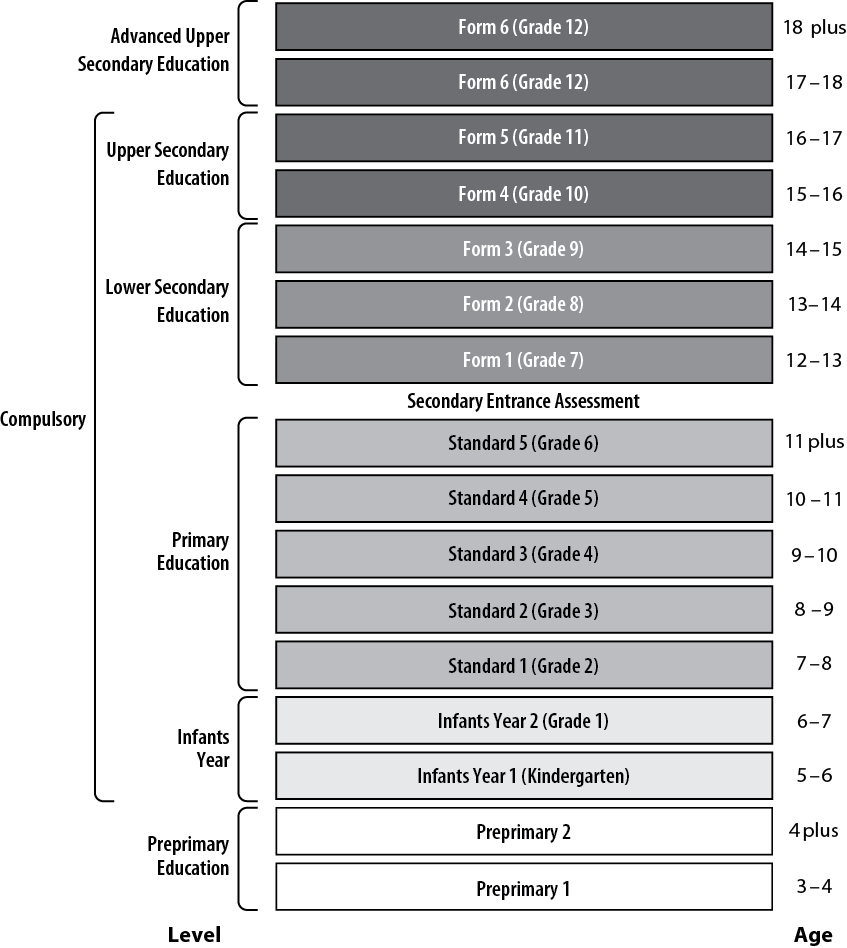Overview of Education System
The education system in Trinidad and Tobago includes publicly and privately funded schools. The country’s education system falls mainly under the jurisdiction of the Ministry of Education. The Tobago House of Assembly and the Ministry of Education collaborate to ensure standardized practices in the education system on the island of Tobago.
The education system comprises five levels: preprimary, primary, secondary, postsecondary (including advanced proficiency, technical, and vocational programs), and tertiary (postsecondary education). The Ministry of Education is the administrative authority for preprimary through tertiary education. Education is compulsory for students ages 5 to 16. Preprimary education, which is not compulsory, at Early Childhood Care and Education (ECCE) centers and nursery schools is provided by government schools, government assisted schools, and private individuals. The Ministry of Education is working toward the goal of universal high quality early childhood care and education through the provision of additional ECCE facilities via public and private partnerships and ongoing construction of new centers in collaboration with the Inter‑American Development Bank. The Ministry has established a preprimary education curriculum, and monitors all aspects of this level’s educational and developmental roles. The Ministry monitors all schools over which it has direct control, with policy being prepared to encompass all early childhood care programs.4
Preprimary education lasts two years, with children typically entering the program at age 3. The curriculum at this level involves readiness for learning, play, music, sound, movement, visual creativity, and expression. Some programs focus on emerging written language acquisition and reading. There are 211 public centers in Trinidad and Tobago, including 152 government centers and 59 Service Volunteered for All centers. There are 904 private ECCE centers, and a company called Education Facilities Company Limited has opened 80 newly constructed ECCE centers, with an additional 26 centers yet to be constructed. The Ministry of Education’s planning division is developing ECCE positions and policies to help further the goal of universal high quality ECCE centers.
Primary education begins with a two year course termed Infant Years 1 to 2 (kindergarten to Grade 1) for students ages 5 to 6. Students continue into Standards 1 to 5 (Grades 2 to 6) at ages 7 to 11 plus. Curriculum guides contain content specifications for English Language Arts, Mathematics, Social Studies, Science, Agricultural Science, Physical Education and Health, Spanish, Values, Character and Citizen Education, and Visual and Performing Arts (which include visual arts, music, dance, and drama). Religious instruction is common among denominational schools. Selected primary schools also have piloted Spanish. Primary education culminates in the Secondary Entrance Assessment, a selection mechanism for passage into secondary education.
Secondary education offers a great degree of program variety, with a wide range of subject choices for students ages 12 to 18 plus. Lower secondary education comprises Forms 1 to 3 (Grades 7 to 9) for students ages 12 to 14. Upper secondary education comprises Forms 4 to 5 (Grades 10 to 11) for students ages 15 to 16. Advanced level schools provide a two year program termed Form 6 (Grade 12) for students ages 17 to 18 plus. Secondary schools also offer continuation classes at the upper secondary level (Forms 4 to 5; Grades 10 to 11) for students who must repeat or complete courses. Exhibit 1 presents the education levels in Trinidad and Tobago from the preprimary through advanced secondary levels.
Exhibit 1: Overview of Preprimary Through Secondary Education in Trinidad and Tobago5
In addition to public secondary and advanced level schools, several youth development and apprenticeship centers not managed by the Ministry of Education offer technical and vocational education. Institutions including the University of the West Indies, the University of the Southern Caribbean, and the University of Trinidad and Tobago offer various education degree and training programs at the tertiary level. Foreign universities collaborate with local institutions to provide additional tertiary education options. Education continues to be high on the national agenda and has received a high proportion of the government’s budgetary allocation over the years. During the 2014–2015 fiscal year, approximately 8.621 billion Trinidad and Tobago dollars were allocated to education and training.6

